
The full edition of our giant 62-page June edition of Tudor Life Magazine. It’s a fantastic look into Henry VIII’s fourth wife, Anne of Cleves.
[Read More...]
The full edition of our giant 62-page June edition of Tudor Life Magazine. It’s a fantastic look into Henry VIII’s fourth wife, Anne of Cleves.
[Read More...]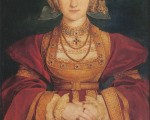
Thank you so much to our regular contributor, Heather R. Darsie, for writing this article on Anne of Cleves for us. Heather is working on a biography of Anne at the moment and is researching her using the German archives.
Anna von Kleve, known to English speakers as Anne of Cleves, left her homeland in December 1539 to join her new husband, Henry VIII of England. The two had been married by proxy a couple of months earlier, in October. After Henry successfully negotiated the marriage alliance with Anna’s younger brother Wilhelm, Duke of Cleves since early 1538, there was the simple matter of getting Anna to England. But which way to take, a sea route or over land? Both options would take Anna through Imperial and French territory, which was no small matter at the time.
[Read More...]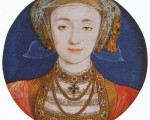
On this day in history, 22nd September 1515, Anna von Jülich-Kleve-Berg, or Anne of Cleves as we know her, was born near Düsseldorf. She was the second daughter of John III, Duke of Jülich, Cleves and Berg, an important German ruler, and his wife, Maria of Jülich-Berg.
[Read More...]
Yesterday was the anniversary of the death of Anne of Cleves on 16th July 1557, so I thought it would be good to mark the occasion with an Anne of Cleves themed quiz. How much do you know about this Tudor queen consort? Test yourself with this fun quiz.
[Read More...]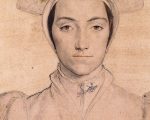
After just over six months of marriage, on 9 July 1540, Anna von Kleve, more commonly known as Anne of Cleves, was divorced from Henry VIII of England. As part of her reward for acquiescing so easily to Henry’s request, she would forever after be known in England as the Daughter of Cleves and Henry’s sister, though she signed letters to her brother as “Anna, born Duchess of Cleves,” or a variation thereof.
Anna was gifted many properties, including Chelsea and Hever Castle, the childhood home of Anne Boleyn. Anna maintained a relationship not only with Henry but also with his daughters Mary and Elizabeth. Anna would go on to live the rest of her life in England before dying at the age of 41. She never returned to the Holy Roman Empire, parts of which comprised most of what we know today as Germany.
[Read More...]
In today’s Claire Chats I look at the evidence regarding Henry VIII’s claims that Anne of Cleves was unattractive and the origin of the “Flanders Mare” label.
[Read More...]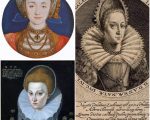
For Part II of the Annes of Cleves, we’ll learn a little bit more about Henry VIII’s fourth wife, Anne of Cleves; her niece, Anna of Cleves; and Anna, Duchess of Cleves. Throughout the article, I will address them as Anne, Anna of Cleves, and the Duchess, so as to help in understanding who is who.
Anne of Cleves, born in 1515 in Germanic territories of the Holy Roman Empire, married Henry VIII of England in 1540. Her marriage to the King lasted only about six months before he divorced her. Due to Anne’s congeniality, Henry settled a good income and several properties on Anne. She remained in England until her death in 1557, where she enjoyed a relationship with Mary I of England, who was only six months Anne’s junior, and with Elizabeth I of England. Elizabeth and Anne rode together in the chariot just after Mary I’s during Mary’s triumphant ride through London as the new queen. Sadly, Anne passed away just over a year before her other stepdaughter, Elizabeth I, become queen.
[Read More...]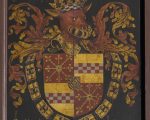
The name “Anne of Cleves” conjures up thoughts of Henry VIII’s allegedly unattractive, unfashionable fourth wife. However, over the span of almost 200 years, there were five women known as “Anne of Cleves”. First, we will meet Anne of Burgundy, who by marriage became an Anne of Cleves. For purposes of this article, we will refer to her as “van Kleef.” Next, we will meet the daughter of Johann II of Cleves, aunt to the famous Henry VIII’s fourth wife. We will call her “von Cleve” throughout this article. Finally, we will quickly look into the early life of Anne of Cleves, the most well-known to the English-speaking world.
[Read More...]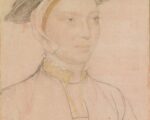
On this day in Tudor history, 20th February 1552, Anne Herbert, Countess of Pembroke, died at Baynard’s Castle in London.
Anne was the younger sister of Queen Catherine Parr and served Queens Anne Boleyn, Jane Seymour, Anne of Cleves and Catherine Howard.
Let me give you a few facts about this Tudor countess…
[Read More...]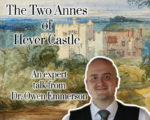
This month our guest expert is Dr Owen Emmerson, the castle historian at Hever Castle in Kent. Owen has given us a real treat with his video.
[Read More...]
On this day in Tudor history, 16th July 1546, in the reign of King Henry VIII, Protestant martyrs Anne Askew, John Lascelles, John Adams and Nicholas Belenian were burned at the stake at Smithfield in London for heresy.
Poor Anne had been illegally racked, so special provision had to be made for her execution.
In today’s talk, I share an account of the ends of these courageous people, along with some trivia about one of them.
[Read More...]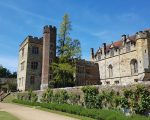
I started Day 3 of the Anne Boleyn Experience 2019 off well with a Full Hever Breakfast – yum! And then it was time to head off to nearby Penshurst Place, home of Edward Stafford, Duke of Buckingham, before it was seized by the crown after his execution and its keepership granted to Thomas Boleyn. In Edward VI’s reign, it was granted to the Sidney family and has been in that family ever since.
[Read More...]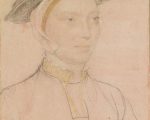
Anne Parr was born on 15th June 1515, in the early years of Henry VIII’s reign. Her parents were Sir Thomas Parr and Maud Green. Thomas was an English knight, courtier, and Lord of the Manor of Kendal in Westmorland (current day Cumbria). Perhaps more famously known in contemporary historiography as the younger sister of Katherine Parr, the sixth wife of Henry VIII, Anne Parr has remained a particularly elusive character in terms of research, when compared to her fashionable contemporaries. However, she led an equally interesting and eventful life. Despite the Parr daughters having a northern-born father, they grew up in the south of England. Their father’s seat at Kendal castle was, during their childhood, falling into disrepair, and living in the south was more practical in terms of their father’s role at court; Westmorland simply being too far from the centre of government and monarchy. In a manner more cosmopolitan, the Parr family resided at their modest house in Blackfriars, where Anne and Katherine were likely born and raised. This relative closeness to the court was convenient for Maud Parr, who was one of Queen Catherine of Aragon’s primary ladies in waiting.
[Read More...]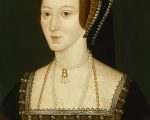
hank you to regular contributor Heather R. Darsie for this article on the famine of 1527 and how the common people may have seen it.
In the Tudor period, life was very much governed by the church, and people in England generally, at least outwardly, were religious and God-fearing. Witchcraft was thought to exist, and God could express his pleasure or displeasure, or otherwise send signs through any number of mediums. Did God try to warn Henry VIII, or even Anne Boleyn, that their courtship was ultimately doomed? By 1527, it was no secret that Henry VIII harboured an affection for Anne Boleyn. In May of that year, Henry was explaining to Cardinal Wolsey why he felt he was living in sin by having married his deceased brother’s wife. Cardinal Wolsey had been made legatus a legere, putting him in the position of the most powerful religious figure in England. Henry relied on a passage from the Christian bible, namely Leviticus 20:21, which states, “And if a man shall take his brother’s wife, it is an unclean thing: he hath uncovered his brother’s nakedness; they shall be childless.” Henry, of course, had his daughter Mary with Catherine, but no male heir and several stillbirths or infants who only lived for a few weeks. But this was not enough to ensure the Tudor dynasty.
[Read More...]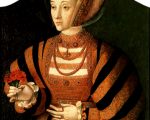
Anna von Kleve, from the line of von der Marck (Germanic) or LaMarck (Francophone), fourth wife of Henry VIII and most commonly known as Anne of Cleves, is known to have shared the lineage of King Edward I of England with Henry’s other five wives. While an interesting anecdote, Edward I, or Edward Longshanks, Hammer of the Scots, died in 1307. In 1539, when Anna came to England to be Henry’s queen, she had many well-known powerful relations, distant though they were. Below, we will go through the genealogy of some of Anna’s royal connections.
[Read More...]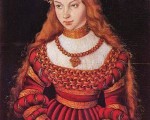
Sibylle von Kleve was born on 17 January 1512 and eventually became older sister to Anna von Kleve, more commonly known as Anne of Cleves or Henry VIII’s fourth wife, in 1515. Sibylle, the eldest of Maria von Julich-Berg’s children with Duke Johann von Kleve, was elevated to the station of Electress Consort through her marriage to Johann Friedrich I, the Elector of Saxony, in 1527.
As Electress of Saxony, Sibylle enjoyed a fruitful marriage with Johann Friedrich and had four sons, three of whom survived to adulthood. Sibylle was known as a great beauty, as can be seen from her engagement portrait by Lucas Cranach the Elder from 1526 (left hand portrait). Her long, golden-brown hair is loose and flowing about her shoulders. Lucas Cranach the Elder and his workshop would go on to produce many portraits of Sibylle and her family, including one finished in 1531, when Sibylle was 29. In the 1531 portrait of Sibylle (right hand portrait), we see that she likely plucked back her hairline, as was fashionable in the period as a high forehead showed that a woman was of noble bearing and intelligent.
[Read More...]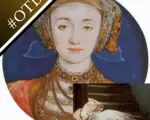
Today is the traditional date given for the birth of Anne of Cleves, fourth wife of Henry VIII; and it’s also the anniversary of the burial of Amy Dudley (née Robsart), wife of Robert Dudley, Earl of Leicester, at St Mary’s Church, Oxford…
[Read More...]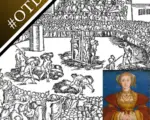
On this day in Tudor history, Frances Grey (née Brandon), Duchess of Suffolk, was born; Anne Askew was burnt at the stake for heresy with two others; and Anne of Cleves, Henry VIII’s fourth wife, died at Chelsea Old Manor…
[Read More...]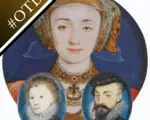
On this day in Tudor history, 9th July, Henry VIII’s marriage to Anne of Cleves was officially annulled; the Lady Mary (Mary I) wrote to the Privy Council stating her claim to the throne and demanding their allegiance; and Elizabeth I began a 19-day visit at Robert Dudley’s home, Kenilworth Castle…
[Read More...]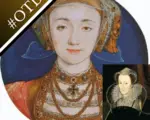
On this day in Tudor history, 20th June, Anne of Cleves complained about Henry VIII’s flirting with Catherine Howard; the Casket Letters, which would be used to condemn Mary, Queen of Scots, were discovered; and Henry Percy, 8th Earl of Northumberland, allegedly shot himself through the heart…
[Read More...]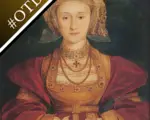
What happened on this day in Tudor history? Let me share with you some events from 3rd January during the reigns of the Tudor monarchs…
1521 – Pope Leo X issued the papal bull Decet Romanum Pontificem excommunicating reformer, German priest and professor of theology Martin Luther from the Catholic Church. See below.
1540 – Official reception of Anne of Cleves at Greenwich Palace. See below.
1541 – Anne of Cleves visited Hampton Court Palace to greet her former husband, Henry VIII, and his new wife, Catherine Howard, and to exchange New Year’s gifts.

On this day in Tudor history, 16th August 1549, in the reign of King Edward VI, landowner and administrator Sir Christopher More died. He was buried in St Nicholas’s Church, Guildford, in the Loseley Chapel.
More was a Justice of the Peace and sheriff during the reign of Henry VIII and was appointed to the guard of honour prepared for Anne of Cleves in late 1539.
Here are some facts about Sir Christopher More:
Sir Christopher More was born in around 1483 and was the son of fishmonger John More and his wife, Elizabeth.
By 1504, More was married to Margaret Mugge, who came from Guildford, and the couple had 12 children together. By 1535, Margaret had died and More had married Constance Sackville, widow of William Heneage.
In 1505, in the reign of King Henry VII, More was made a clerk of the exchequer, and More also purchased the office of alnager, i.e. an inspector of the quality and measurement of woollen cloth, in Surrey and Sussex.
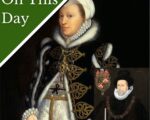
On this day in Tudor history, 26th April 1540, in the reign of King Henry VIII, sixteen year-old Catherine Carey married Francis Knollys.
Catherine was the daughter of William Carey and Mary Boleyn, and the niece of Queen Anne Boleyn. Although some believe that she was Henry VIII’s daughter, there is no evidence for this.
Catherine served as a maid of honour to Anne of Cleves, and went into exile with her family in Mary I’s reign.
Catherine was appointed to her cousin Elizabeth I’s bedchamber in 1559. She served there until her death in 1569.
[Read More...]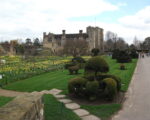
A few weeks ago, my father and I were able to get away for a morning to visit Hever Castle in Kent. It’s somewhere that you may have been to before, and it’s a castle that is very close to our hearts – we LOVE the way the grounds are kept and how the castle evokes the history of the Boleyn family, the time Anne of Cleves spent there AND, more recently, how the Astor family lived and renovated the whole area.
For a long time, Hever castle was quite static in its displays – not much changed, which was fine if you’d never visited before, but since we had visited so many times, it was rare to see anything new. That’s no longer the case.
[Read More...]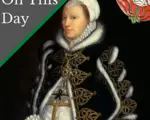
On this day in Tudor history, 26th April 1540, Catherine Carey, daughter of Mary Boleyn and a maid of honour to Queen Anne of Cleves, married Francis Knollys.
The marriage was happy and successful, and resulted in at least 14 children…
[Read More...]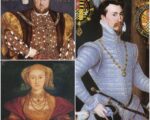
On this day in Tudor history, 4th September 1539, William, Duke of Cleves, signed the marriage treaty promising his sister, Anne of Cleves, in marriage to King Henry VIII.
Anne would of course become Henry VIII’s fourth wife.
Find out all about the marriage agreement and its terms, and what happened next…
[Read More...]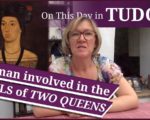
On this day in Tudor history, 28th April 1548 (some sources say 6 May), courtier, diplomat, soldier and Keeper of Oatlands Palace, Sir Anthony Browne, died at Byfleet in Surrey. He had been one of Henry VIII’s most important and richest courtiers and was also involved in the falls of two queens: Anne Boleyn and Anne of Cleves.
Find out more about this man and how he was involved in the falls of the two Annes in today’s talk.
[Read More...]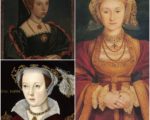
This week’s Sunday fun is a true or false quiz testing your knowledge on Henry VIII’s six wives. Part 2 focuses on Anne of Cleves, Catherine Howard and Catherine Parr.
Good luck!
[Read More...]